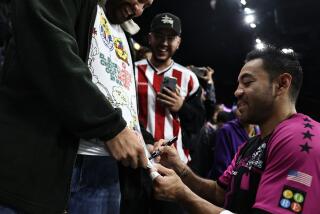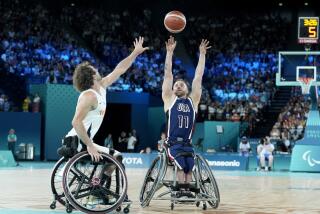One-Legged Soccer : Amputees Play in Pain . . . and Love It
- Share via
WOODINVILLE, Wash. — It was Saturday morning scrimmage for a most unusual soccer team at the sports arena in this Seattle suburb.
Players kicked the ball, hit the ball with their heads, blocked the ball as it flew toward the goal.
The rules were the same.
Only the players were different.
Each was missing a leg. They played on crutches. It was the regular weekly practice session for the nation’s first one-legged soccer team.
Play was as rugged as collegiate soccer. And well it should be, for the team’s opponents include the University of Washington, Seattle-Pacific University and other college varsity teams. (The college teams play on crutches and players can use only one leg.)
The fast-moving ball bounced off players, bruising arms, body, head, legs.
Now and then players spilled and slid across the floor of the indoor court. There were crunching collisions as in regular soccer play.
“Often in the heat of action crutches are broken. We expect that,” said Rod Hitchcock, 36, forward on the team and maintenance supervisor at the Kingdome. He lost his left leg in a motorcycle accident 2 1/2 years ago.
“I’m on my third set of crutches. This game not only hurts at times. It also costs. You pay $50 for a crutch,” he said, laughing.
When not playing soccer, members of the team wear artificial legs.
There are 18 players, ages 17 to 55, both men and women, on Seattle’s National Handicapped Sport and Recreation Assn. (NHSRA) one-legged soccer team sponsored by the Athlete’s Foot sporting goods chain.
The team has been playing non-handicapped teams once or twice a month and has won 80% of the games it has played so far. Games also are scheduled with the new Portland and Vancouver one-legged teams.
“Our goalies are also handicapped, but instead of missing a leg, they are missing an arm,” Don Bennett noted. “Goalies on teams we play are required to use only one arm during the game.”
Play as in regular soccer lasts an hour. Scores are usually low. In a recent game with the University of Washington varsity soccer team, UW won, 6-4.
“Look. The other team is out to win just as we are. They don’t feel sorry for us and we don’t want them to. We don’t feel sorry for them. It’s tough on them to hobble around on crutches,” said Fadl Khalil, 29, a Boeing electrical engineer.
“It takes time to get the hang of balance when using crutches, to learn how to kick the ball with one leg. We have much more upper body strength than our non-handicapped opponents.”
Khalil lost his leg in his native Lebanon when he was 19. “I was a civilian not involved in any way in the fighting over there,” he explained. “I just happened to be in the wrong place at the wrong time.”
He had a brother in this country and came here to be outfitted with an artificial leg and to go to school. Khalil is one of the originals on the one-legged team.
‘A Natural Thing’
“I played soccer as a kid, so this is a natural thing for me. When we first started we hit the ball with a crutch instead of kicking it with our leg. I proposed we make hitting the ball with the crutch illegal. My suggestion prevailed,” he said.
For Khalil, playing soccer “is good for the body and good for the soul. It really gives us a great lift.”
One-legged soccer is the brainstorm of Don Bennett, 55, president of Video Training Center, a management training company, headquartered in Bellevue, Wash.
Bennett, father of seven children, lost his right leg in a boating accident 15 years ago. He was a mountain climber before the accident and in 1980 he decided to climb Mt. Rainier. He trained two years for the climb.
“My first attempt I got within 400 feet of the 14,410-foot summit. A howling windstorm nearly blew us off the mountain. My hiking companions and I had to give up,” Bennett said.
But he was successful on his second attempt, which took him five days. He reached the peak July 15, 1982, the first person with such a handicap ever to scale Mt. Rainier.
After he came off the mountain Bennett looked for a sports activity to keep himself in shape. He thought of soccer, got a half dozen of his one-legged friends together, and the team was formed in September, 1982.
Earlier this year a group of one-legged men and women organized a team in Portland, Ore., and more recently another team was formed in Vancouver, B.C.
A Nationwide Sport?
“What we’re hoping for is for the sport to go nationwide, to have teams in cities across the America,” Bennett said. “We would like to see a Pacific Coast league formed with teams organized in San Francisco, Los Angeles, San Diego and other cities in California, Washington and Oregon.
“My dream is to have one-legged soccer become a major sport with teams from not only the United States but from Canada and Mexico as well and with an international trophy on the order of the Stanley Cup.”
One of the women players on the team, Sarah Doherty, 25, inspired by Bennett’s conquest of Rainier, climbed the mountain last summer. An occupational therapist, Doherty lost her leg 13 years ago when a drunk driver’s car struck her while she was riding a bicycle.
This last May 29, Doherty spent 20 days with two companions successfully climbing to the summit of 20,320-foot Mt. McKinley, the highest peak in North America.
Many of the players for the Seattle team were recruited by Dee Malchow, 40, the team’s right forward, mother of two, a nurse who works with amputees at Seattle’s Harborview Hospital. She lost her right leg in a boating accident in 1964.
Malchow met several of the present players as they were recovering from surgery after losing a leg.
“None of us in this fix can afford to sit around and feel sorry for ourselves. We have to pick up the pieces of our lives and concentrate not on what we can’t do, but on all the things we can do,” Malchow said.
“Soccer for us builds self-confidence. It gives us an added dimension to life. It’s exciting. We develop tremendous trust and respect for ourselves and for one another.”
Bone Cancer
Ken Eriksen, 33, a vocational rehabilitation counselor and defensive back on the team, lost his right leg to bone cancer 18 years ago. “Playing soccer has turned my life around,” Eriksen said. “I feel good about myself again. It has given me a chance to get back into team sports. I wrestled, played baseball and football in high school, then I lost my leg.
“It’s easy to become sedentary, to sit around and feel sorry for yourself, to say I can’t do those things anymore. You’d be surprised what we can do.”
Dan Vincent, 33, a sporting goods salesman, lost his right leg in a hunting accident three years ago. “Dee talked to me about skiing and soccer in the hospital right after I lost my leg. She convinced me in a period of great depression that I could get on with my life,” Vincent said.
He started skiing and playing soccer, two sports he had never tried before. Vincent is one of the keys to the team’s success. He has done remarkably well on the ski slopes, ranking 13th nationally this year on the U.S. Handicapped Ski Team.
Launched Study
Donald Labourr, sports therapy director of Seattle’s Mason Clinic Sports Medicine Center, recently launched a long-term study of the one-legged soccer players to determine the effects of playing the game on their bodies.
Labourr is simultaneously running tests on professional soccer players for comparative results.
The handicapped players report to the clinic after each Saturday morning scrimmage. All admit having a lot of pain in their leg and in other parts of their bodies while playing and after the game is over.
But none complain.
“Sure there’s pain. But that’s part of the game,” Bennett insisted. “Anybody playing hard-hitting soccer, whether they have two legs or one, gets battered around and banged up. We expect it.
“We love it.”






